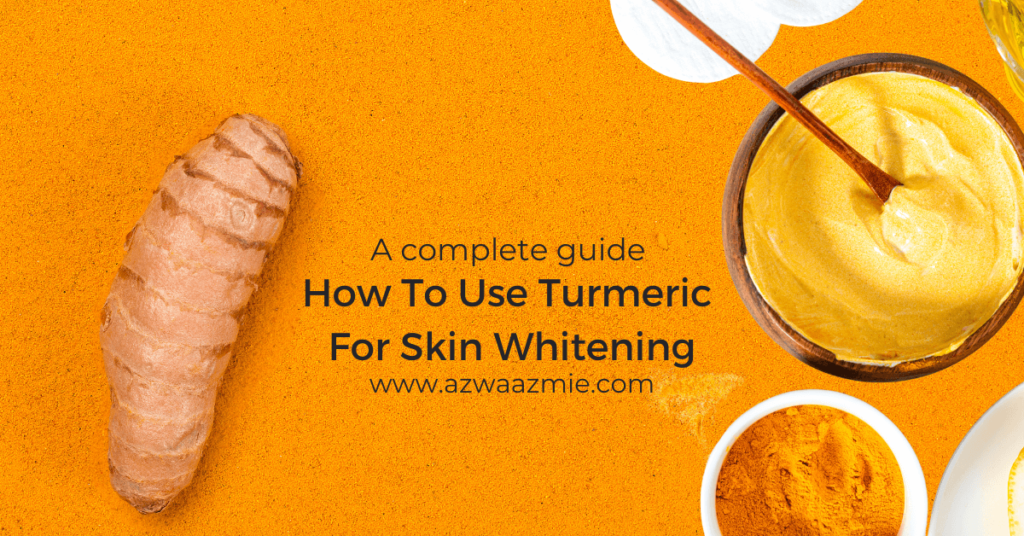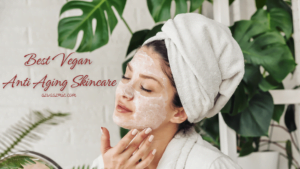
As a mom, you’re probably always looking for new ways to keep your skin healthy and glowing or wanting your child to look the best, and healthy glowing skin is the key to that. However, today’s pollution and unhealthy lifestyle can make it difficult to maintain healthy-looking skin.
Well, have you heard of the latest craze? Many people are now turning to turmeric as an effective way to lighten their complexion without resorting to harsh chemicals or expensive treatments.
If you want brighter, youthful-looking skin but don’t want to break the bank, then learning how to use turmeric for skin whitening may be just what you need! In this blog post we’ll explore this hot topic in detail; covering everything from preparation techniques and recipes through benefits and side effects – so buckle up – it’s time for some skincare adventure!
In this guide, I will explain everything you need to know about how to use turmeric for skin whitening. Interested? Keep reading to find out more wonders turmeric can do, you would be surprised at how useful it is in skincare!
What makes Tumeric so Special?
Turmeric is known for its anti-inflammatory and antiseptic properties and has been used for cosmetic purposes for centuries. It can reduce inflammation, ward off toxins, and repair skin damage.
What other Benefits does Turmeric Offer?
Apart from skin whitening, turmeric is a versatile spice that offers a plethora of other benefits.
- It is widely used in cooking for its unique flavor and vibrant color.
- In the realm of health, turmeric is known for its potent antioxidant properties that aid in combatting harmful free radicals in the body.
- It also contributes to boosting the immune system and improving overall health.
- When it comes to beauty, besides skin whitening, turmeric is known to alleviate conditions like acne and eczema due to its antibacterial and anti-inflammatory qualities.
- It’s also used in hair care products to stimulate hair growth and tackle scalp conditions.
- Moreover, in traditional medicine, turmeric is utilized for its potential benefits in managing digestive issues, reducing pain, and even mitigating the risk of chronic conditions like heart disease and cancer.
Different Ways on How to Use Turmeric for Skin Whitening
1. Turmeric for Acne and Pimples
Turmeric’s antiseptic and antibacterial properties can help prevent acne and pimples thus fighting acne-prone skin. The magic ingredient is a compound called curcumin, which has been proven to reduce inflammation, skin oil secretion, and bacteria growth.
Here’s how to use turmeric for acne and pimples:
- Mix 1 tsp of turmeric powder with 1 tbsp of honey and a few drops of lemon juice to form a paste.
- Apply the paste to your face and leave it for 15-20 minutes.
- Rinse off with warm water and pat dry.

2. Turmeric for Dark Spots and Pigmentation
Dark spots, acne scars, and hyperpigmentation can be stubborn and tricky to get rid of. Turmeric can help in fading out these problems by reducing excess melanin production and exfoliating dead skin cells.
Here’s how to use turmeric for Dark Spots and Pigmentation:
- Mix 1 tsp of turmeric powder and 1 tbsp of plain yogurt in a bowl.
- Apply the paste to your face and let it sit for 20 minutes.
- Rinse it off thoroughly with warm water and pat dry.

3. Turmeric for Skin Brightening
Turmeric’s antioxidant properties can remove dullness from the skin and bring back the youthful glow. This is how you can use turmeric for skin brightening:
Here’s how to use turmeric for Skin Brightening:
- Make a blend of 1/2 tsp turmeric, 1 tsp gram flour, and 1 tbsp milk.
- Apply it to your face and neck and leave it for 15-20 minutes.
- Rinse off with warm water.

4. Turmeric for Skin Exfoliation
Exfoliation is essential to remove dead skin cells, unclog pores, and let the skin breathe. Turmeric can act as a natural exfoliant for your skin. Here’s how you can use turmeric for skin exfoliation:
Here’s how to use turmeric for Skin Exfoliation:
- Mix 1 tsp turmeric powder, 1 tbsp of honey, and 2 tbsp of sugar.
- Apply it on your face, and gently massage it in a circular motion.
- Leave for 10-15 minutes and rinse off with warm water.

Skin Care Tips to Keep in Mind
Be cautious while using turmeric for skin whitening as it can stain your clothes. Use an old T-shirt or towel to cover your clothes while applying. Also, be aware that turmeric can leave a yellowish hue on your face for a while.
More Examples of Natural Ingredients you can Find at Home that are Beneficial
There are several natural ingredients commonly found at home that you can use for skincare purposes. Here are some examples:
- Honey: Honey is a natural humectant that helps retain moisture, making it excellent for dry skin. It also has antibacterial properties and can be used in face masks or as a cleanser.
- Oatmeal: Oatmeal is great for exfoliating and soothing sensitive or irritated skin. You can use it as a gentle scrub or mix it with other ingredients to create a calming face mask.
- Yogurt: Yogurt contains lactic acid, which can help exfoliate the skin and improve its texture. It’s also hydrating and can be used in masks or as a cleanser.
- Lemon: Lemon juice is a natural source of vitamin C and can help brighten the skin. It can be diluted with water and used as a toner or mixed with other ingredients for a face mask.
- Coconut Oil: Coconut oil is a moisturizing oil that can be used for dry skin and as a makeup remover. It’s rich in fatty acids and has antimicrobial properties.
- Aloe Vera: Aloe vera gel has soothing and hydrating properties, making it ideal for sunburn relief and as a moisturizer for sensitive skin. You can use fresh aloe gel or store-bought aloe vera products.
- Cucumber: Cucumber slices or cucumber juice can help reduce puffiness and refresh the skin. They are often used as natural eye masks or facial toners.
- Avocado: Avocado is rich in healthy fats and vitamins, making it an excellent ingredient for moisturizing masks. It can help nourish and rejuvenate the skin.
- Baking Soda: Baking soda is a gentle exfoliant that can help remove dead skin cells. However, it should be used sparingly and with caution, as it may be too abrasive for sensitive skin.
- Tea Bags: Used tea bags (e.g., green tea or chamomile) can be applied to the eyes to reduce puffiness and dark circles. Tea extracts also have antioxidant properties beneficial for the skin.
Conclusion
So how was it? Was this ‘How to Use Turmeric for Skin Brightening’ blog helpful for you who’s looking for skin care recipes or convince some of you to incorporate more turmeric in your skincare routine? Turmeric is an affordable and natural ingredient that can do wonders for your skin’s appearance. By following the methods I mentioned, you can safely use turmeric for skin whitening and enjoy healthy, plump skin, and bright skin.
Remember, beauty comes from within, so don’t forget to consume a healthy diet, exercise, and take proper care of yourself.
FAQ
Is turmeric effective for skin whitening?
Turmeric can help improve the complexion and reduce the appearance of dark spots, but it may not drastically whiten the skin. It’s more effective at providing a natural glow and even skin tone.
Can turmeric cause skin irritation or allergies?
Turmeric is generally safe for most skin types, but it may cause irritation or allergies in some individuals. It’s recommended to do a patch test before applying turmeric to your face to check for any adverse reactions.
Does turmeric stain the skin or clothes?
Turmeric can stain the skin temporarily, especially if left on for too long. To prevent stains, remove the turmeric paste within the recommended time frame. It can also stain clothes, so be cautious when using it.
Can I use turmeric alone, or should I mix it with other ingredients?
While turmeric can be used alone, combining it with other natural ingredients like honey, yogurt, or lemon juice can enhance its effectiveness and reduce the risk of staining or irritation.
Are there any side effects of using turmeric for skin whitening?
Turmeric is generally safe for topical use, but excessive use or leaving it on for extended periods can cause temporary yellowing of the skin. People with very sensitive skin or allergies to curcumin (the active compound in turmeric) should use it with caution and consult a dermatologist if necessary.




